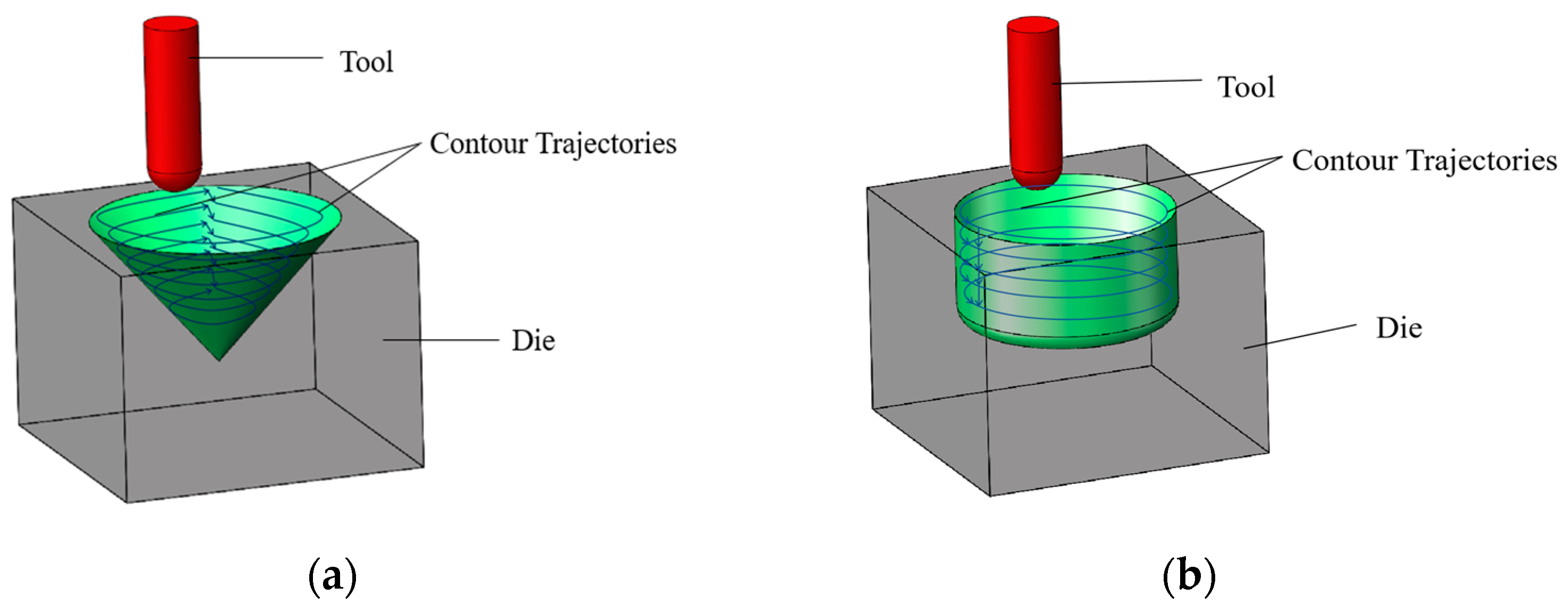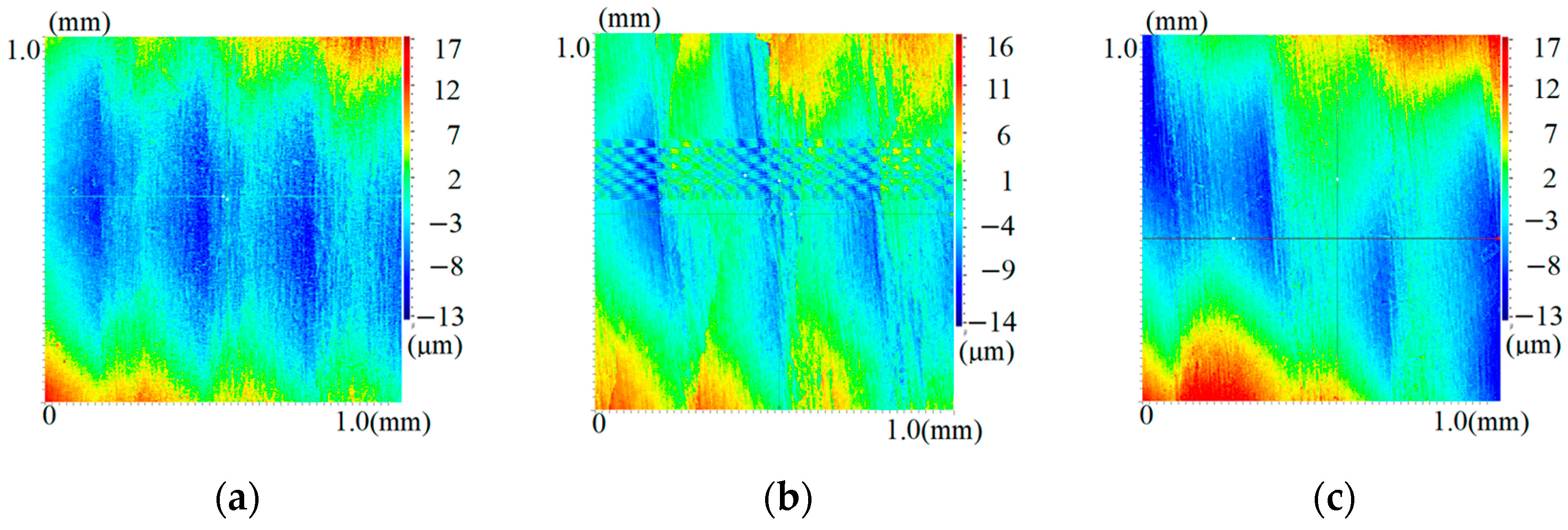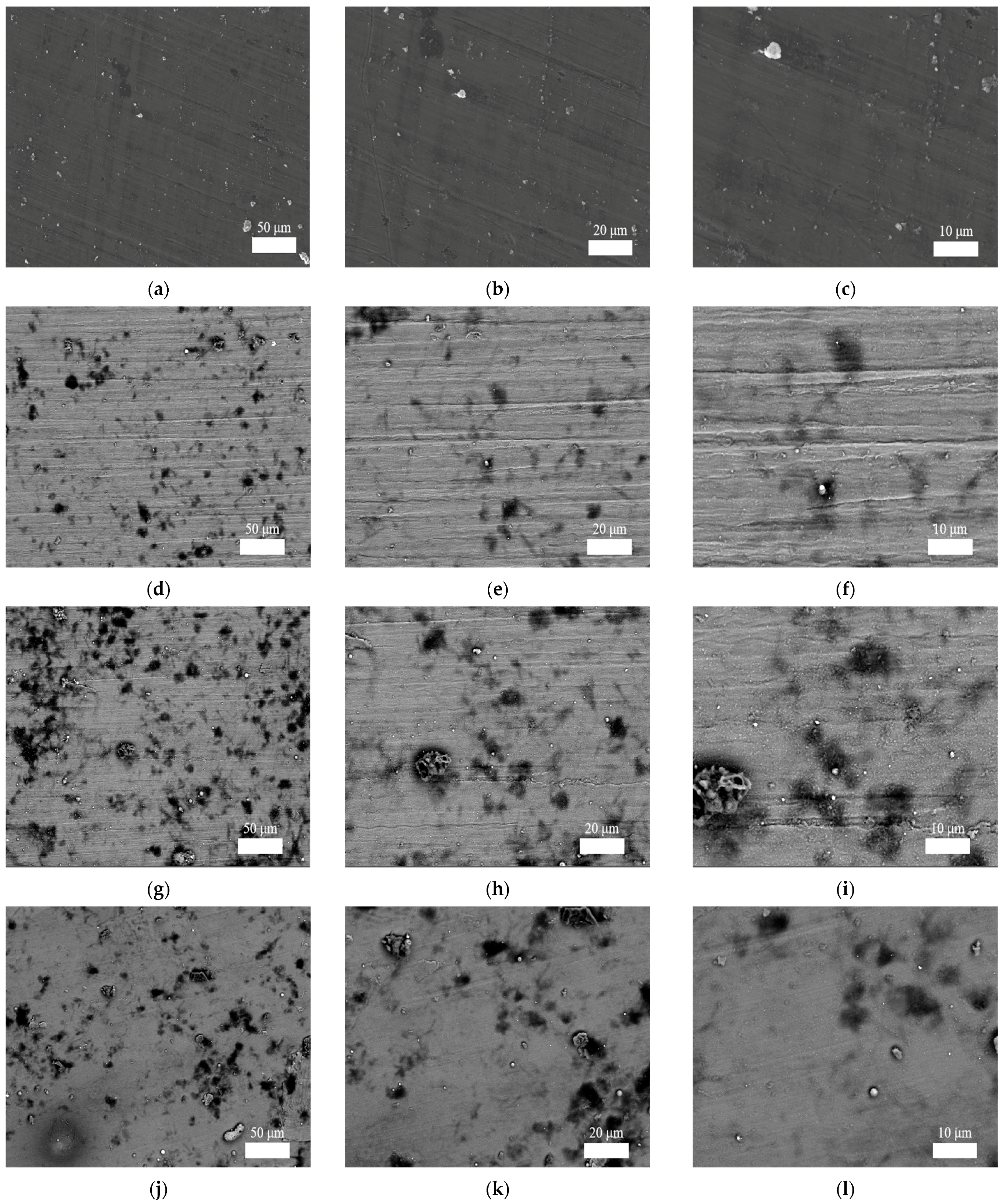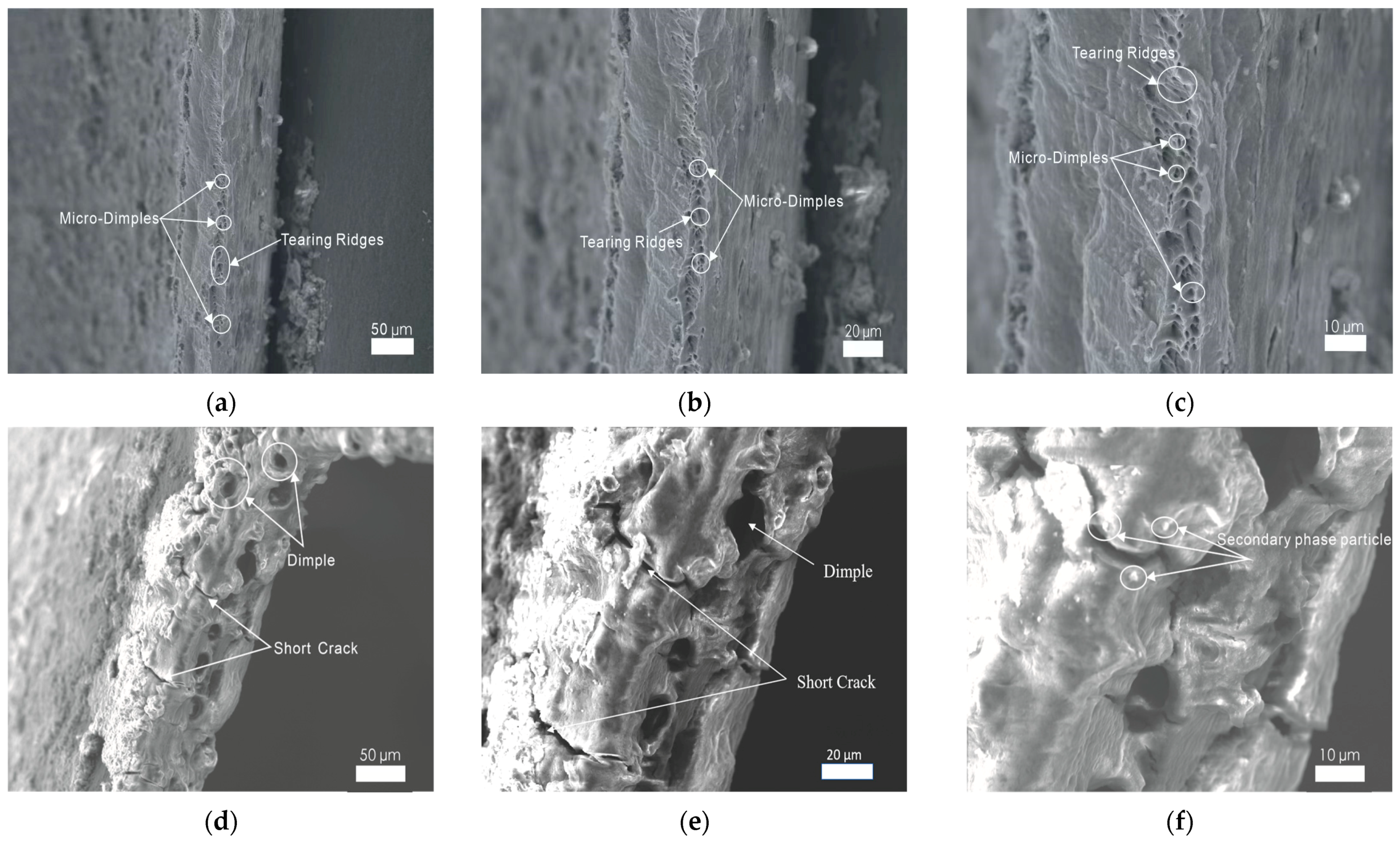Characteristics of 2D Ultrasonic Vibration Incremental Forming of a 1060 Aluminum Alloy Sheet
Abstract
:1. Introduction
2. Materials and Methods
2.1. Experimental Materials
2.2. Specimens and Tools
2.3. Method of Experiment
2.3.1. Processing Principle
2.3.2. Processing Equipment
2.3.3. Processing Conditions
3. Results and Discussion
3.1. Surface Topography Analysis
3.2. Micro-Hardness Analysis
3.3. Residual Stress Analysis
3.4. Microstructure Images
4. Conclusions
Author Contributions
Funding
Institutional Review Board Statement
Informed Consent Statement
Data Availability Statement
Conflicts of Interest
References
- Wang, Z.; Ma, M.; Qiu, Z.; Zhang, J.; Liu, W. Microstructure, texture and mechanical properties of AA 1060aluminum alloy processed by cryogenic accumulative roll bonding. Mater. Charact. 2018, 139, 269–278. [Google Scholar] [CrossRef]
- Rasti, J. Study of the welding parameters effect on the tunnel void area during friction stir welding of 1060 aluminum alloy. Int. J. Adv. Manuf. Technol. 2018, 97, 2221–2230. [Google Scholar] [CrossRef]
- Borgert, T.; Neuser, M.; Schaper, M.; Homberg, W.; Wiens, E.; Grydin, O. Schaper. Influence of thermo-mechanical joining process on the microstructure of a hypoeutectic aluminium cast alloy. Mat. Res. Proc. 2023, 25, 187–194. [Google Scholar] [CrossRef]
- Tyagi, S.A.; Bhadauria, N.; Vashishtha, P.; Mishra, S. Improving surface hardness of aluminum 6063 alloy using hardfacing. Mater. Today 2020, 26, 1343–1346. [Google Scholar] [CrossRef]
- Hama, T.; Yagi, S.; Tatsukawa, K.; Maeda, Y.; Maeda, Y.; Takuda, H. Evolution of plastic deformation behavior upon strain-path changes in an A6022-T4 Al alloy sheet. J. Plast. 2021, 137, 102913. [Google Scholar] [CrossRef]
- Zhan, L.; Xie, H.; Yang, Y.; Zhao, S.; Chang, Z.; Xia, Y.; Zheng, Z.; Zhou, Y. Investigation on creep deformation and age strengthening behavior of 304 stainless steel under high stress levels. Materials 2024, 17, 642. [Google Scholar] [CrossRef]
- Duflou, J.R.; Habraken, A.-M.; Cao, J.; Malhotra, R.; Bambach, M.; Adams, D.; Vanhove, H.; Mohammadi, A.; Jeswiet, J. Single point incremental forming:state-of-the-art and prospects. Int. J. Mater. 2017, 11, 743–773. [Google Scholar] [CrossRef]
- Maqbool, F.; Bambach, M. Dominant deformation mechanisms in single point incremental forming (SPIF) and their effect on geometrical accuracy. Int. J. Mech. Sci. 2018, 136, 279–292. [Google Scholar] [CrossRef]
- Borgert, T.; Nordieker, A.; Wiens, E.; Homberg, W. Investigations to improve the tool life during thermomechanical and incremental forming of steel auxiliary joining elements. Int. J. Adv. Join. Process. 2024, 9, 100185. [Google Scholar] [CrossRef]
- Puche, M.B.; Palomo, D.; Martínez-Donaire, A.J.; Morales-Palma, D.; Vallellano, C. Ductile fracture analysis in Nakazima vs. SPIF tests. In Proceedings of the 10th Manufacturing Engineering Society International Conference, Sevilla, Spain, 28–30 June 2023. [Google Scholar] [CrossRef]
- Rusu, G.-P.; Breaz, R.-E.; Popp, M.-O.; Oleksik, V.; Racz, S.-G. Experimental research on wolfram inert gas AA1050 aluminum alloy tailor welded blanks processed by single point incremental forming process. Materials 2023, 16, 6408. [Google Scholar] [CrossRef]
- Ostasevicius, V.; Eidukynas, D.; Jurenas, V.; Paleviciute, I.; Gudauskis, M.; Grigaliunas, V. Investigation of advanced robotized polymer sheet incremental forming process. Sensors 2021, 21, 7459. [Google Scholar] [CrossRef]
- Esmaeilpour, R.; Kim, H.; Asgharzadeh, A.; Tiji, S.A.N.; Pourboghrat, F.; Banu, M.; Bansal, A.; Taub, A. Experimental validation of the simulation of single-point incremental forming of AA7075 sheet with Yld2004-18P yield function calibrated with crystal plasticity model. Int. J. Adv. Manuf. Technol. 2021, 113, 2031–2047. [Google Scholar] [CrossRef]
- Puga, H.; Barbosa, J.; Machado, J.; Vilarinho, C. Ultrasonic grain refinement of die cast copper alloys. J. Mater. Process. Technol. 2019, 263, 336–342. [Google Scholar] [CrossRef]
- Khan, S.; Hussain, G.; Ilyas, M.; Rashid, H.; Khan, M.I.; Khan, W.A. Appropriate heat treatment and incremental forming route to produce age-hardened components of Al-2219 alloy with minimized form error and high formability. J. Mater. Process. Technol. 2018, 256, 262–273. [Google Scholar] [CrossRef]
- Ho, K.-T.; La, N.-T.; Chu, N.-H.; Vu, N.-H.; Mai, T.-L. Applying Ultrasonic-assisted incremental sheet forming to Al 5052 aluminum alloy. Eng. Proc. 2023, 45, 8. [Google Scholar] [CrossRef]
- Yang, M.; Bai, L.; Li, Y.; Yuan, Q. Influences of vibration parameters on formability of 1060 aluminum sheet processed by ultrasonic vibration-assisted single point incremental forming. Adv. Mater. Sci. Eng. 2019, 2019, 8405438. [Google Scholar] [CrossRef]
- Liu, S.; Shan, X.; Guo, K.; Yang, Y.; Xie, T. Experimental study on titanium wire drawing with ultrasonic vibration. Ultrasonics 2018, 83, 60–67. [Google Scholar] [CrossRef] [PubMed]
- Gohil, A.; Modi, B.; Patel, K. Effect of amplitude of vibration in ultrasonic vibration-assisted single point incremental forming. Mater. Manuf. Process. 2022, 37, 1837–1849. [Google Scholar] [CrossRef]
- Zhou, H.; Cui, H.; Qin, Q.H. Influence of ultrasonic vibration on the plasticity of metals during compression process. J. Mater. Process Technol. 2018, 251, 146–159. [Google Scholar] [CrossRef]
- Amini, S.; Gollo, A.H.; Paktinat, H. An Investigation of conventional and ultrasonic-assisted incremental forming of annealed AA1050 sheet. Int. J. Adv. Manuf. Technol. 2016, 90, 1569–1578. [Google Scholar] [CrossRef]
- Ashish, M.; Gohil, B.; Modi, A.; Kaushik, M. Ultrasonic vibration-assisted single point incremental forming of hemispherical shape using multi-stage forming strategy. J. Manuf. Syst. 2020, 13, 247–265. [Google Scholar] [CrossRef]
- Obikawa, T.; Hayashi, M. Ultrasonic-assisted incremental microforming of thin shell pyramids of metallic foil. Micromachines 2017, 8, 142–152. [Google Scholar] [CrossRef]
- Vahdati, M.; Mahdavinejad, R.; Amini, S. Investigation of the ultrasonic vibration effect in incremental sheet metal forming process. Proc. Inst. Mech. Eng. B J. Eng. Manuf. 2017, 231, 971–982. [Google Scholar] [CrossRef]












| Si | Fe | Cu | Mn | Mg | V | Zn | Ti | Al |
|---|---|---|---|---|---|---|---|---|
| 0.25 | 0.35 | 0.05 | 0.03 | 0.03 | 0.05 | 0.05 | 0.03 | ≥99.60 |
| Topography Parameters | Max Value | Min Value | Mean Value | Standard Deviation |
|---|---|---|---|---|
| Mean roughness/Ra | 3.150 | 1.691 | 2.421 | 1.032 |
| Maximum peak height/Rp | 9.679 | 5.425 | 7.552 | 3.008 |
| Root Mean square deviation/Rq | 3.657 | 2.097 | 2.877 | 1.103 |
| Maximum valley depth/Rv | −5.136 | −7.459 | −6.298 | 1.643 |
| Maximum height difference/Rz | 17.138 | 10.562 | 13.850 | 4.650 |
| Topography Parameters | Max Value | Min Value | Mean Value | Standard Deviation |
|---|---|---|---|---|
| Mean roughness/Ra | 3.077 | 1.888 | 2.661 | 0.670 |
| Maximum peak Height/Rp | 10.693 | 5.544 | 8.594 | 2.703 |
| Root mean square deviation/Rq | 4.031 | 2.311 | 3.346 | 0.912 |
| Maximum valley depth/Rv | −5.617 | −8.708 | −7.590 | 1.713 |
| Maximum height difference/Rz | 19.401 | 11.162 | 16.184 | 4.406 |
| Topography Parameters | Max Value | Min Value | Mean Value | Standard Deviation |
|---|---|---|---|---|
| Mean roughness/Ra | 2.081 | 1.794 | 1.938 | 0.203 |
| Maximum peak height/Rp | 6.622 | 5.851 | 6.237 | 0.545 |
| Root Mean square deviation/Rq | 2.474 | 2.260 | 2.367 | 0.151 |
| Maximum valley depth/Rv | −4.993 | −7.004 | −5.999 | 1.422 |
| Maximum height difference/Rz | 12.855 | 11.615 | 12.235 | 0.877 |
| Parameters | Sample for SPIF | Sample for LUVIF | Sample for 2D-UVIF |
|---|---|---|---|
| Pitch | 100 µm | 100 µm | 100 µm |
| X-ray irradiation measure time | 90 s | 90 s | 90 s |
| X-ray irradiation max time | 120 s | 120 s | 120 s |
| X-ray tube current | 1.50 mA | 1.50 mA | 1.50 mA |
| X-ray tube voltage | 30.00 kV | 30.00 kV | 30.00 kV |
| Sample distance (monitor) | 65.000 mm | 65.000 mm | 65.000 mm |
| Sample distance (analysis) | 63.908 mm | 65.990 mm | 66.174 mm |
| X-ray incidence angle | 35.0° | 35.0° | 35.0° |
| Offset of alpha angle | 0° | 0° | 0° |
| X-ray wavelength (K-alpha) | 2.29093[A] (Cr) | 2.29093[A] (Cr) | 2.29093[A] (Cr) |
| X-ray wavelength (K-beta) | 2.08480[A] (Cr) | 2.08480[A] (Cr) | 2.08480[A] (Cr) |
| Total measurement count | 45,376 | 45,381 | 45,386 |
| Oscillation count | 7 | 7 | 7 |
| Detection sensitivity | 53.4% | 39.6% | 56.5% |
| Peak strength | 317 k | 144 k | 211 k |
| Level of ambient light | 0.3% | 0.3% | 0.3% |
| Temperature | 38.38 °C | 46.50 °C | 43.69 °C |
| Valid range of alpha angle | 18–90° | 18–90° | 18–90° |
| Peak analysis method | Fitting Lorentz | Fitting Lorentz | Fitting Lorentz |
Disclaimer/Publisher’s Note: The statements, opinions and data contained in all publications are solely those of the individual author(s) and contributor(s) and not of MDPI and/or the editor(s). MDPI and/or the editor(s) disclaim responsibility for any injury to people or property resulting from any ideas, methods, instructions or products referred to in the content. |
© 2024 by the authors. Licensee MDPI, Basel, Switzerland. This article is an open access article distributed under the terms and conditions of the Creative Commons Attribution (CC BY) license (https://creativecommons.org/licenses/by/4.0/).
Share and Cite
Lv, Y.; Wang, Y.; Wang, Y.; Pan, X.; Yi, C.; Dong, M. Characteristics of 2D Ultrasonic Vibration Incremental Forming of a 1060 Aluminum Alloy Sheet. Materials 2024, 17, 1235. https://doi.org/10.3390/ma17061235
Lv Y, Wang Y, Wang Y, Pan X, Yi C, Dong M. Characteristics of 2D Ultrasonic Vibration Incremental Forming of a 1060 Aluminum Alloy Sheet. Materials. 2024; 17(6):1235. https://doi.org/10.3390/ma17061235
Chicago/Turabian StyleLv, Yuan, Yifan Wang, Yan Wang, Xixiang Pan, Cong Yi, and Meng’en Dong. 2024. "Characteristics of 2D Ultrasonic Vibration Incremental Forming of a 1060 Aluminum Alloy Sheet" Materials 17, no. 6: 1235. https://doi.org/10.3390/ma17061235






